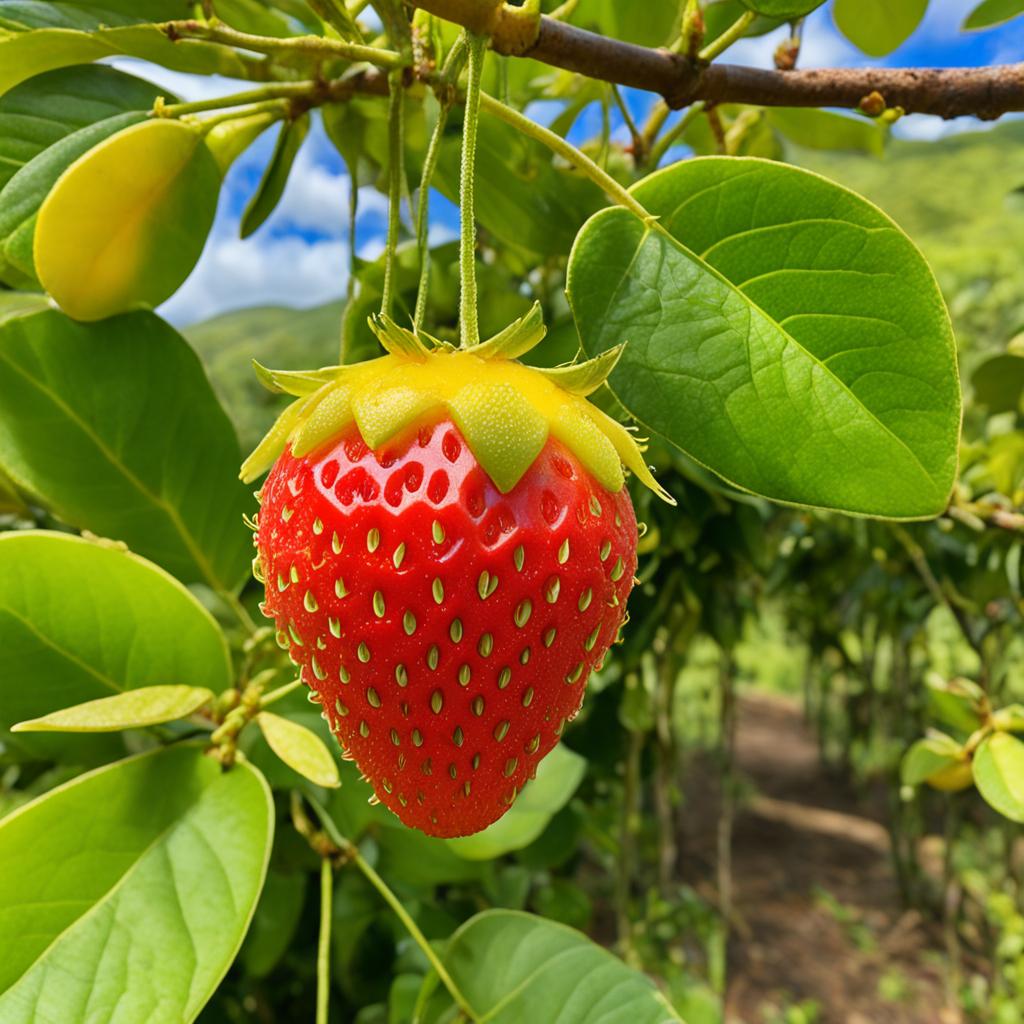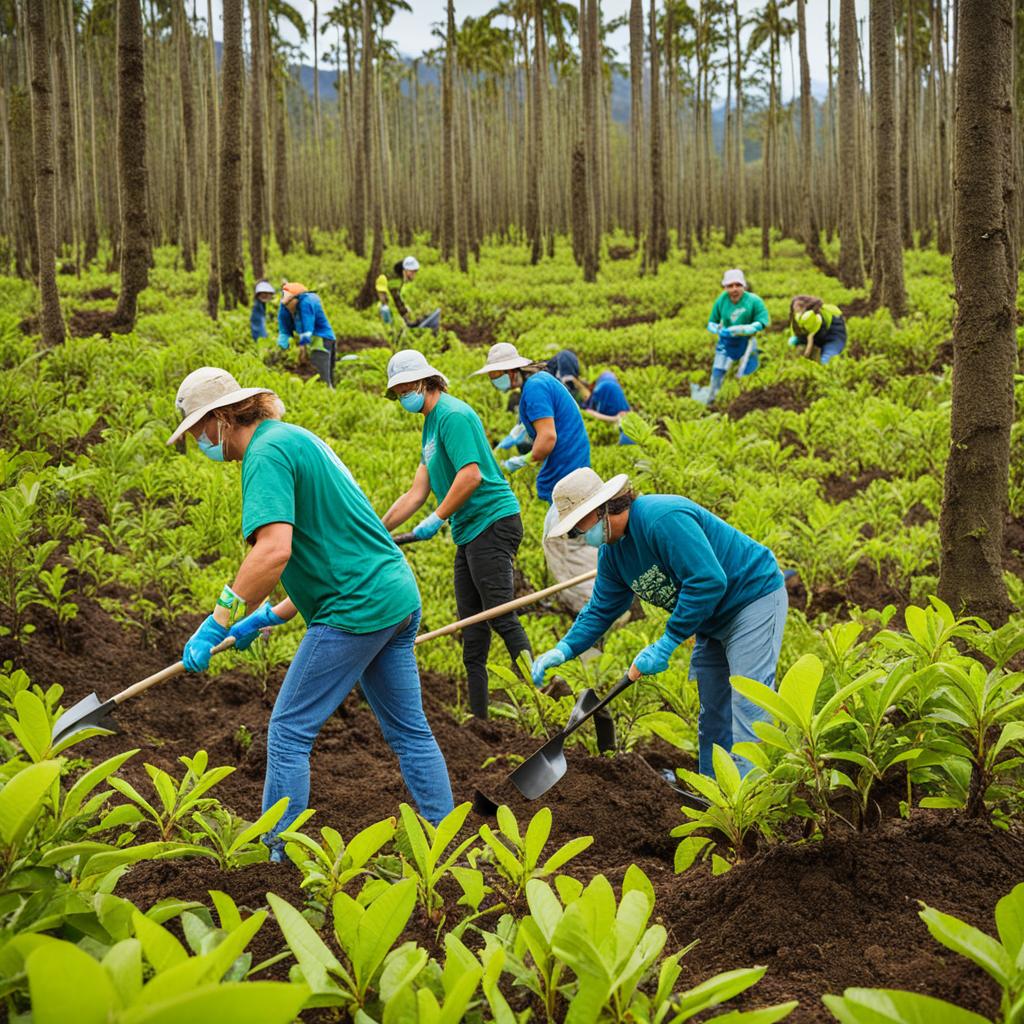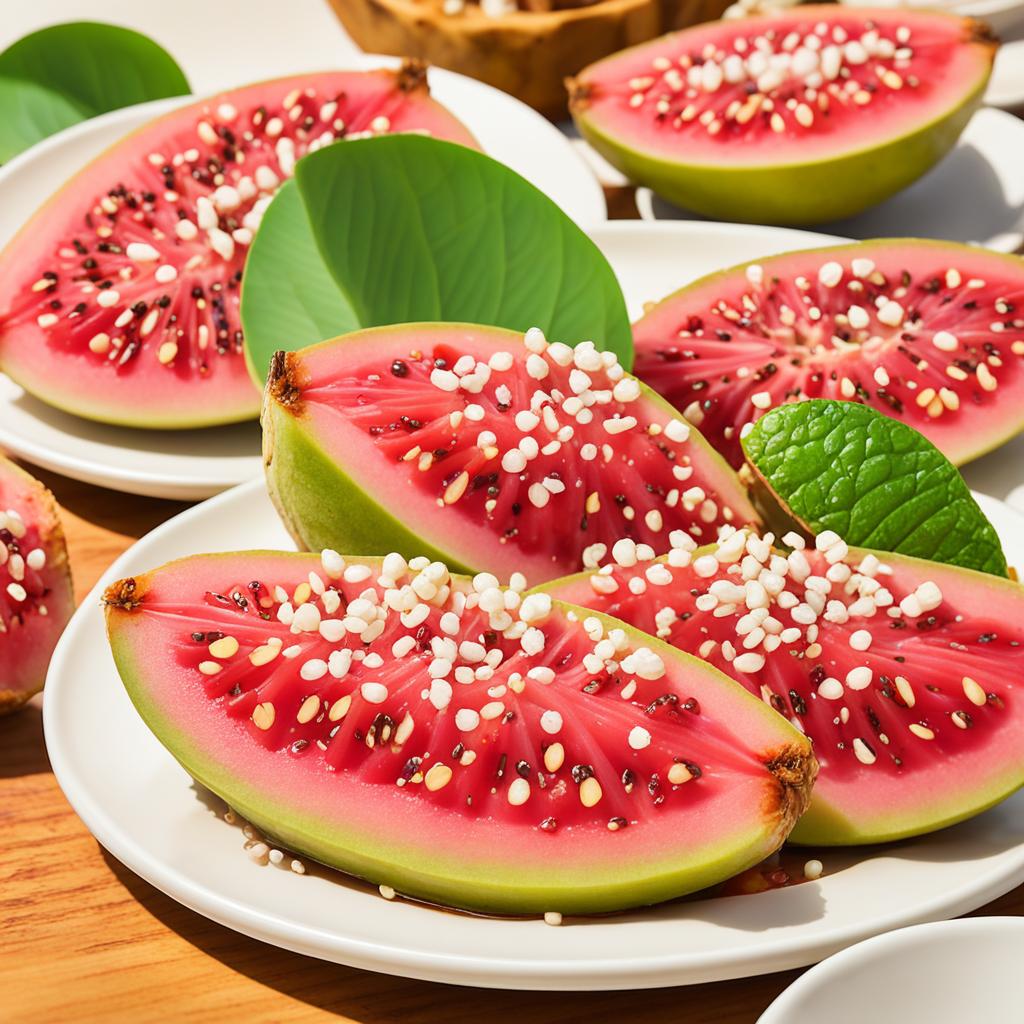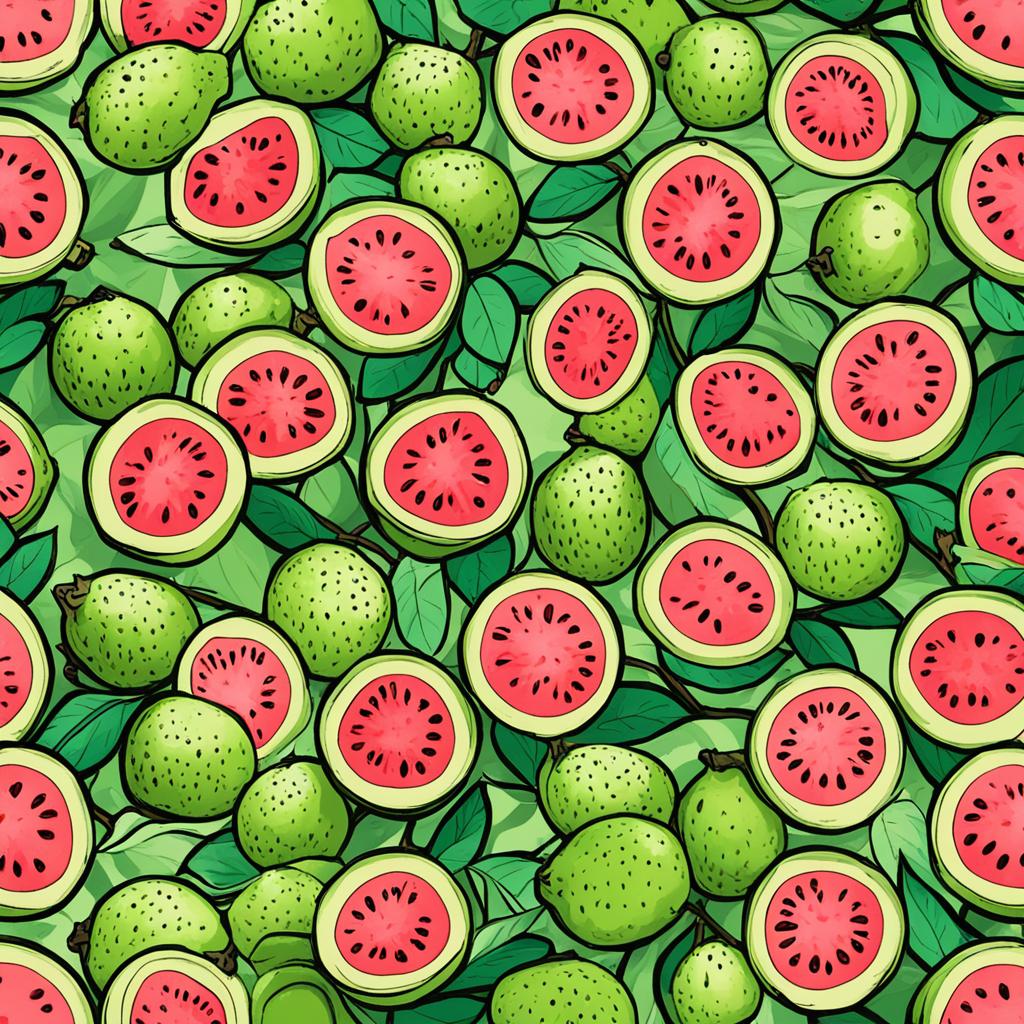When you think of Hawaii, tropical fruits like guava often come to mind. But did you know that not all guava varieties found in Hawaii are native to the islands? The guava fruit was actually brought to Hawaii from Central and South America, adding a flavorful touch to the archipelago’s diverse agricultural landscape.
So, what types of guava grow in Hawaii? Are they all the same, or are there distinct Hawaiian guava varieties? Join us as we take a closer look at the fascinating world of guava in Hawaii. From invasive species to culinary delights and medicinal uses, we’ll explore the impact and significance of guava on the islands’ ecosystems, economy, and culture.
The Invasive Strawberry Guava in Hawaii

Strawberry guava, scientifically known as Psidium cattleianum, is considered one of the most invasive tree species in Hawaii. Its introduction to the islands has had significant ecological impacts, posing a threat to native flora and disrupting delicate ecosystems.
The spread of strawberry guava is facilitated by feral pigs and birds, which consume its fruit and disperse the seeds over vast areas. This enables the guava to colonize diverse environments and elevations throughout Hawaii. As a result, it has become a pervasive presence in both lowland forests and high-elevation rainforests, outcompeting and displacing essential native plants.
One of the most alarming consequences of strawberry guava’s invasion is its profound impact on endangered plants in Hawaii. Approximately 25% of the state’s endangered flora is at risk due to the encroachment of this invasive species. The dense foliage of strawberry guava effectively shades out native plants, limiting their access to sunlight and vital resources.
Furthermore, the growth of strawberry guava has detrimental effects on the local hydrological balance. The species has been shown to reduce groundwater recharge, influencing water availability in certain regions. This can have cascading effects on the health and sustainability of ecosystems that depend on stable water sources.
To combat the ecological impact of strawberry guava, various control measures have been implemented. One such strategy involves the introduction of a natural predator, the scale insect Tectococcus ovatus. This insect helps reduce the vigor and reproductive capacity of the guava trees without completely eradicating them.
Despite these efforts, the control of strawberry guava remains a significant challenge. It requires a comprehensive and integrated approach involving continued research, monitoring, and management strategies. Only through such efforts can the ecological balance be restored and the impacts of this invasive species be mitigated.
| Ecological Impact of Strawberry Guava on Hawaii | Control Measures |
|---|---|
|
|
Common Guava and Its Impact in Hawaii
Another guava variety found in Hawaii is common guava, also known as kuawa. While this tropical fruit offers wood, fruit, and medicinal properties, it can become problematic when not properly managed. Common guava has the potential to overrun fields and roadsides, making it an invasive weed in Hawaii.
This invasive nature of common guava poses a significant challenge, particularly in pasture lands where it competes with native vegetation and diminishes the available feed for livestock. Mowing alone is not an effective control method as it often leads to regrowth with multiple stems, exacerbating the issue.
Despite its invasive tendencies, common guava is still cultivated in Hawaii due to its culinary value. The fruits of common guava are used to make delicious jams, jellies, and other products that are enjoyed by both locals and visitors.
Controlling the Spread of Guava in Hawaii

To mitigate the detrimental effects of guava on Hawaii’s ecosystems, efforts have been made to control its spread. Several strategies have been employed, including:
- Eating guava fruits before they fall to the ground, preventing further seed dispersal
- Minimizing large-scale production of guava to reduce its impact
- Implementing localized farming practices to better control the spread of guava trees
By adopting these measures, you can contribute to controlling guava and reducing its spread in Hawaii.
One simple way you can personally make a difference is by enjoying guava fruits yourself before they have a chance to fall. This prevents the seeds from being dispersed and helps contain the growth of guava trees. By doing so, you play an active role in preventing the further spread of guava in Hawaii.
In addition to individual actions, large-scale production of guava has been limited to minimize its impact on the environment. This approach ensures that the guava trees’ population is kept under control, reducing the potential for their spread and invasion of native habitats.
Localized farming practices have also proven effective in controlling guava. By adopting these practices, all fruits are removed from the trees, preventing them from falling and germinating elsewhere. This targeted approach allows for better management and containment of guava trees, reducing their spread and preserving the integrity of Hawaii’s ecosystems.
| Methods of Controlling Guava Spread | Benefits |
|---|---|
| Eating guava fruits before they fall | – Prevents further seed dispersal |
| Minimizing large-scale production | – Reduces environmental impact |
| Localized farming practices | – Enables better control over guava spread – Preserves native habitats – Lessens ecological disruptions |
The Use of Guava in Hawaiian Cuisine

Guava is a staple ingredient in traditional Hawaiian cuisine, bringing a delightful tropical flavor to a variety of dishes and beverages. Its unique taste and aroma make it a popular choice for locals and tourists alike. From refreshing desserts to tangy sauces, guava-infused products are an integral part of the vibrant Hawaiian food landscape.
One iconic guava creation is the Hawaiian POG, a refreshing juice blend of Passion fruit, Orange, and Guava. Served chilled, this vibrant concoction perfectly captures the essence of the islands. Guava also finds its way into ice cream flavors and sorbets, adding a zesty sweetness that transports your taste buds to paradise.
Guava syrup, made from the fruit’s natural juices, is a popular topping for pancakes, waffles, and cakes. Its rich flavor enhances these breakfast favorites, providing a burst of tropical goodness with every bite. You can also find guava-infused jams and jellies, which make for delicious spreads on toast or as a filling in pastries.
Refreshing shave ice, a beloved Hawaiian treat, is often drizzled with guava syrup, creating a mouthwatering fusion of flavors. The icy-cold goodness combined with the sweet and tangy guava essence is a true island delight.
Furthermore, guava wood is highly valued for grilling and smoking. When used as a cooking fuel, it imparts a subtle and sweet aroma to the food, enhancing the overall taste experience. Whether you’re enjoying a traditional Hawaiian luau or a backyard barbecue, guava wood adds a unique touch to your grilled dishes.
From savory to sweet, guava has found its way into numerous Hawaiian dishes and beverages, showcasing its versatility and irresistible flavor. Whether you’re indulging in a guava-infused dessert or savoring the aromatic nuances of guava-smoked meat, each bite is a celebration of the vibrant Hawaiian culture.
Medicinal Uses of Guava in Hawaii
Guava is not only a delicious fruit but also renowned for its numerous medicinal properties. In Hawaii, various parts of the guava plant, including its leaves, bark, roots, and unripe fruit, have been utilized for centuries due to their remarkable health benefits.
Guava leaves, in particular, are highly esteemed for their medicinal properties. They have been traditionally used to regulate stomach ailments such as diarrhea and dysentery. When brewed into a tea or made into a poultice, guava leaves can also aid in wound healing and reduce scarring. Additionally, the oil extracted from guava leaves is rich in tannin, which is known for its beneficial effects on the skin, especially for individuals with dry or aging skin.
Beyond the leaves, the bark, roots, and unripe fruit of the guava plant also offer medicinal value. The bark and roots have been used in traditional remedies to alleviate toothaches, while the unripe fruit is believed to possess antidiarrheal properties.
Moreover, guava is a natural source of antioxidants, which play a crucial role in neutralizing harmful free radicals in the body. By incorporating guava into your diet, you can enjoy its antioxidant benefits and support your overall well-being.
To summarize, guava in Hawaii goes beyond being a flavorful tropical fruit. Its leaves, bark, roots, and unripe fruit hold significant medicinal uses, ranging from stomach ailment regulation to wound healing and antioxidant support. Incorporating guava into your daily routine not only adds a delicious touch but also contributes to your overall health and wellness.
Guava’s Impact on Hawaiian Economy and Culture
Guava has played a significant role in both the Hawaiian economy and culture. Historically, guava plantations were an integral part of Hawaii’s agricultural industry, contributing to large-scale production and exports. The economic impact of guava was substantial, providing employment opportunities and boosting the local economy.
However, the guava industry in Hawaii has faced challenges in recent years. Foreign markets have affected guava prices, leading to a decline in production. Despite this, guava remains a beloved fruit in Hawaiian culture, deeply ingrained in traditional foods, songs, and even hula implements.
The cultural significance of guava is evident in the way it is embraced and cherished by the Hawaiian people. From classic dishes like guava chiffon pie to the iconic guava juice, this tropical fruit holds a special place in the hearts and taste buds of locals and visitors alike.
In addition to its culinary uses, guava is also symbolic of the lush and vibrant nature of the Hawaiian islands. The sweet and tangy flavor of guava represents the tropical paradise that Hawaii is known for.
While guava production may have declined, localized farming practices are now being implemented to support the Hawaiian food economy. These practices ensure that guava cultivation is done in a sustainable and responsible manner, preserving the cultural significance of guava while minimizing its impact on the environment.
Guava’s Economic Impact in Hawaii
Although the guava industry has faced challenges, it is essential to recognize the historical significance of guava in Hawaii’s economy. Large-scale guava plantations employed many people and contributed to the local economy. The decline in guava production has prompted a shift towards localized farming practices, supporting the sustainability of the industry and preserving the cultural heritage associated with guava.
Guava in Hawaiian Culture
Guava holds a special place in Hawaiian culture, with its use extending beyond culinary delights. Songs and performances featuring guava often celebrate the unique beauty and abundance of the Hawaiian islands. The fruit’s vibrant color and tropical aroma evoke a sense of joy and connection to nature, reflecting the rich traditions and history of the Hawaiian people.
| Guava’s Impact | Economy | Culture |
|---|---|---|
| Economic Contribution | Historically contributed to Hawaii’s agricultural industry | Symbolic of the lush nature of the Hawaiian islands |
| Challenges | Foreign markets impacting guava prices | Preserved in traditional foods, songs, and hula implements |
| Localized Farming | Supporting sustainable guava cultivation | Celebrated for its vibrant color and tropical aroma |
Enjoying Guava in Hawaii
When visiting Hawaii, make sure to indulge in the delicious local guava treats. From delectable jams and jellies to refreshing tropical drinks and mouthwatering desserts, there are numerous ways to savor the unique flavor of guava. By trying these guava-infused delicacies and supporting local businesses, you can truly experience the authentic taste of Hawaii.
Bringing back guava treats as souvenirs allows you to share a piece of Hawaii’s culinary delights with your loved ones who couldn’t join you on the trip. Whether it’s a jar of tangy guava jam or a bag of guava-flavored candies, these delightful treats make for thoughtful and memorable gifts. Sharing the joy of guava is a wonderful way to reminisce about your Hawaiian adventure and introduce others to the flavors of the islands.
Exploring the world of guava treats adds an extra layer of enjoyment to your Hawaiian experience. The versatility of guava in various cuisines and its tropical flair make it an exciting ingredient to discover. So be sure to seek out local bakeries, farmers markets, and specialty stores to try the best guava treats that Hawaii has to offer. From heavenly guava pies to refreshing guava smoothies, each bite will transport you to the sunny shores of paradise.
Guava is not just a fruit but a symbol of Hawaii’s rich cultural heritage and culinary traditions. By immersing yourself in the local guava scene, you not only support the island’s economy but also become part of the guava-loving community. So don’t miss out on the chance to tantalize your taste buds with the delightful flavors of guava while exploring the beautiful islands of Hawaii.
FAQ
Q: What type of guava grows in Hawaii?
A: There are various guava varieties grown in Hawaii, including the invasive strawberry guava and the common guava.
Q: What is the impact of strawberry guava in Hawaii?
A: Strawberry guava is considered one of the most invasive tree species in Hawaii, posing a threat to native flora and disrupting ecosystems.
Q: How does common guava impact Hawaii?
A: Common guava, when not managed, can overrun fields and roadsides, diminishing livestock feed in pasture lands.
Q: What efforts are being made to control the spread of guava in Hawaii?
A: Measures such as eating guava fruits before they fall to the ground and localized farming practices are being implemented to minimize its impact.
Q: How is guava used in Hawaiian cuisine?
A: Guava is used in various dishes and beverages, such as ice cream, juice, syrup, jams, and jellies, adding a tropical touch to culinary creations.
Q: What are the medicinal uses of guava in Hawaii?
A: Guava leaves, bark, roots, and unripe fruit are used for their health benefits, such as regulating stomach ailments and improving skin health.
Q: What is the impact of guava on Hawaiian economy and culture?
A: Guava plantations have contributed to Hawaii’s agricultural industry, but their production has declined. However, guava continues to hold cultural significance in Hawaiian traditions.
Q: How can I enjoy guava in Hawaii?
A: It is recommended to try local guava treats like jams and jellies, support local businesses, and bring guava treats home as souvenirs to share the taste of Hawaii.
